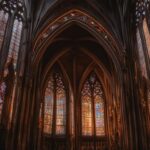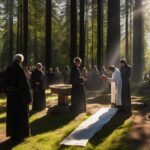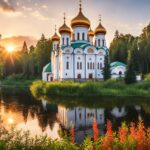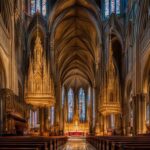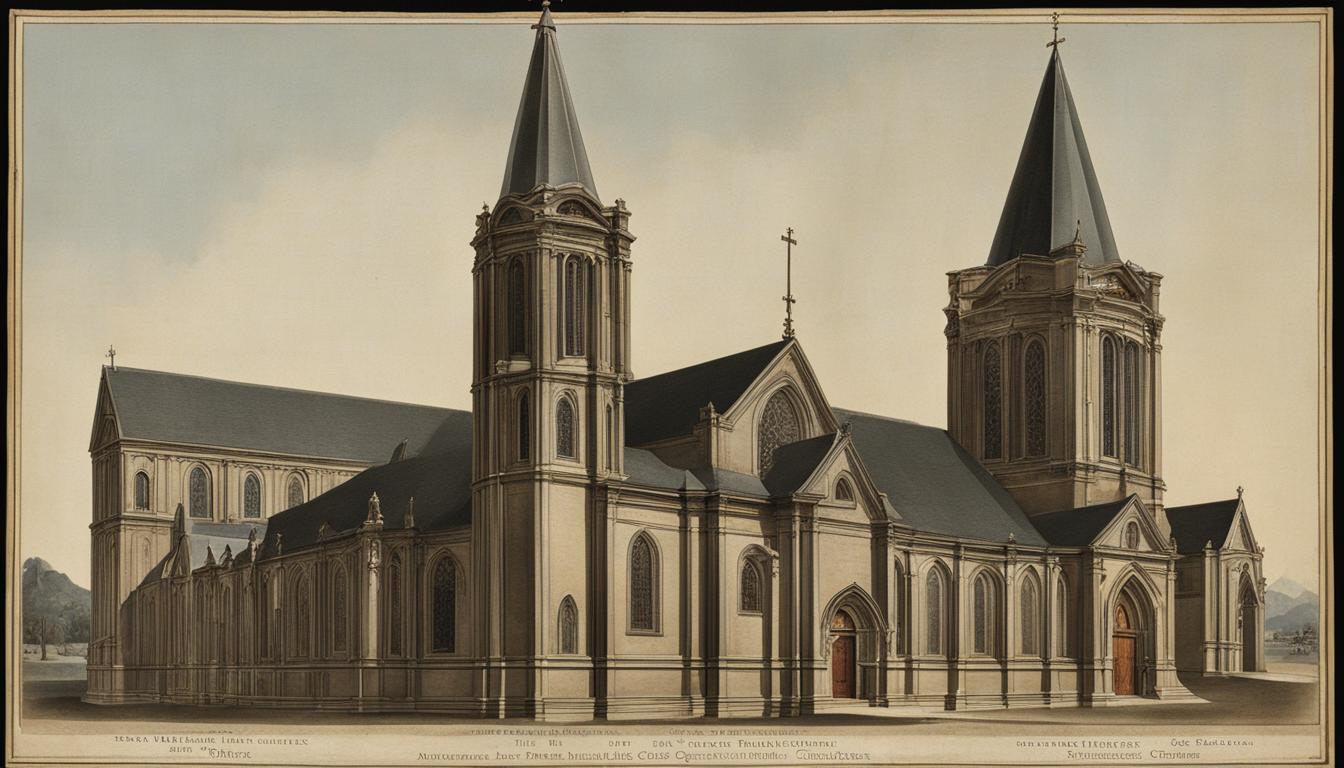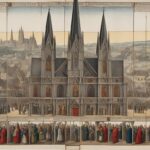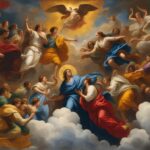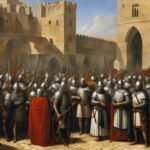The Renaissance period, also known as the “rebirth,” was a time of profound cultural transformation and artistic innovation in Europe. Spanning from the 14th to the 17th centuries, this era saw a revival of interest in classical antiquity and a shift towards humanistic values. Italian Renaissance art, in particular, produced some of the most influential artists and artworks in history.
Leonardo da Vinci, Michelangelo, and Raphael are just a few of the notable artists who emerged during this period. Their masterpieces showcased a departure from religious themes, emphasizing naturalism, perspective, and the beauty of the human form. Through their art, Renaissance artists captured the essence of their time, forever shaping the course of art history.
Key Takeaways:
- The Renaissance period was characterized by cultural change and artistic innovation.
- Renaissance art showcased naturalism, perspective, and the celebration of the human form.
- Italian Renaissance art produced influential artists like Leonardo da Vinci, Michelangelo, and Raphael.
- The artworks of the Renaissance continue to inspire and shape the art world today.
- The Renaissance period marks a turning point in the history of artistic expression.
The Impact of Renaissance Art on Modern Culture
Renaissance art, with its innovative techniques and themes, has had a profound impact on modern culture. Its influence can be seen in various aspects of contemporary society, ranging from education to popular culture and the art world. The artistic achievements of the Renaissance continue to shape our understanding of art and the human experience.
One of the key ways in which Renaissance art has influenced modern culture is through its introduction of new artistic techniques. The use of perspective, which creates a sense of depth and realism in artworks, is a technique that originated in the Renaissance and is still widely used today. Similarly, the emphasis on naturalism, which involves the accurate depiction of the human form and intricate details, has become a fundamental aspect of modern art.
Moreover, the themes explored in Renaissance art have had a lasting impact on contemporary culture. The shift towards secular subjects and the celebration of humanism during the Renaissance challenged the dominance of religious themes in art and opened up new avenues for artistic expression. This departure from traditional religious motifs paved the way for the diversification of artistic content in subsequent periods, including modern art.
Overall, the impact of Renaissance art on modern culture is undeniable. Its techniques, themes, and artistic innovations continue to inspire and shape the art world today. By understanding the legacy of the Renaissance, we can gain a deeper appreciation for the rich artistic heritage that has contributed to our modern cultural landscape.
Table: The Influence of Renaissance Art on Modern Culture
| Influence | Examples |
|---|---|
| Educational impact | Integration of art history curriculum in schools |
| Popular culture references | Renaissance-inspired fashion trends |
| Artistic techniques | Continued use of perspective and naturalism |
| Subject matter | Exploration of secular themes and humanism |
Characteristics of Renaissance Art
Renaissance art is renowned for its distinctive characteristics that set it apart from other artistic periods. These features include:
- Naturalism: Renaissance artists sought to depict the human form with incredible accuracy, focusing on anatomical details and lifelike proportions. They aimed to capture the essence of the natural world and the human experience.
- Perspective: One of the most significant advancements of the Renaissance was the development of linear perspective. Artists used this technique to create a sense of depth and three-dimensional space in their compositions, making them appear more realistic.
- Contrapposto: Renaissance art celebrated the beauty of the human body and often incorporated the contrapposto pose. This pose, in which the weight is shifted to one leg, creates a relaxed and natural stance that conveys a sense of movement and balance.
- Inspiration from Classical Antiquity: Renaissance artists looked to the art and culture of ancient Greece and Rome for inspiration. They studied the works of classical artists and sought to emulate their techniques and ideals.
These characteristics combined to create a distinct style that revolutionized art during the Renaissance period. Artists broke away from the flat, stylized representations of the medieval era and embraced a more naturalistic and human-centered approach.
“Renaissance art was a profound departure from the art of the Middle Ages. It celebrated the beauty and potential of the human form, capturing the intricacies of anatomy and portraying the world with newfound realism and depth. Through their art, Renaissance artists sought to reconnect with the ideals of classical antiquity and celebrate the beauty of the natural world.”
Understanding the characteristics of Renaissance art is crucial for recognizing and appreciating the remarkable contributions of this period to the history of art and culture.
Influential Renaissance Artists
Several talented artists emerged during the Renaissance and left an indelible mark on the art world. These individuals, including Leonardo da Vinci, Michelangelo, and Raphael, exemplified the characteristics of Renaissance art and produced iconic works that continue to inspire and captivate audiences today.
| Artist | Notable Works |
|---|---|
| Leonardo da Vinci | Mona Lisa, The Last Supper |
| Michelangelo | Sistine Chapel ceiling, David |
| Raphael | The School of Athens, Madonna and Child |
These artists pushed the boundaries of artistic expression, showcasing their mastery of technique and their ability to capture the essence of the human form. Their contributions to Renaissance art continue to be celebrated and studied, defining the art of this period and leaving a lasting impact on the world of art.

The image above is a visual representation of Renaissance art. It depicts the artistry and attention to detail that characterized this period, showcasing the naturalistic renderings of the human form, the use of perspective to create depth, and the influence of classical antiquity.
The Medici Family and the Birth of the Renaissance
The Medici family played a crucial role in the birth and patronage of the Renaissance. As wealthy bankers in Florence, they supported artists and scholars, commissioning magnificent artworks that showcased their wealth and influence. The Medici family’s patronage helped transform Florence into a center of art and culture, attracting artists and intellectuals from all over Europe. Their support laid the foundation for the artistic and intellectual achievements of the Renaissance.
During the Renaissance, the Medici family provided financial support to artists such as Leonardo da Vinci, Michelangelo, and Sandro Botticelli, among others. They commissioned numerous works of art, including sculptures, paintings, and architecture, which adorned Florence and shaped the city’s identity. The Medici’s patronage extended beyond the visual arts to literature, science, and philosophy, fostering an environment of creativity and innovation in Florence.
Patronage and Influence
The Medici family’s patronage went beyond financial support; they also provided artists with opportunities for education and exposure, allowing them to refine their craft and gain recognition. The Medici’s support enabled artists to experiment with new techniques and subject matter, pushing the boundaries of artistic expression. Their patronage created a thriving artistic community in Florence, where artists could collaborate, exchange ideas, and learn from one another.
The Medici family’s influence extended beyond Florence and had a significant impact on the development of Renaissance art throughout Italy and Europe. As influential patrons, their support and endorsement of artists helped elevate their status and reputation, leading to increased demand for their work. The Medici family’s promotion of artistic and cultural pursuits laid the groundwork for the flourishing of the arts during the Renaissance.
Legacy and Significance
The Medici family’s patronage and support of the arts left a lasting legacy on Renaissance art and culture. Their investments in artists and their works helped shape the artistic landscape of the time and contributed to the transformative nature of the Renaissance period. The Medici family’s support not only nurtured individual artists but also created an environment that fostered creativity, innovation, and intellectual growth.
The Medici family’s influence on the birth of the Renaissance cannot be overstated. Their patronage of the arts, along with their contributions to literature, science, and philosophy, laid the foundation for the cultural and artistic advancements of the time. The Medici family’s legacy as patrons of the Renaissance continues to be celebrated and studied, highlighting their significant role in the development of Western art and culture.
The Chronology of Renaissance Art
Renaissance art, spanning from the 14th to the 17th centuries, can be divided into several distinct phases, each characterized by unique styles and artistic developments. Understanding the chronology of Renaissance art is essential to appreciate the evolution and impact of this transformative period.
Proto-Renaissance
The Proto-Renaissance period, which preceded the Renaissance proper, saw artists like Giotto and Cimabue laying the foundation for the artistic developments that would follow. It marked a departure from the flat and stylized art of the Middle Ages, with artists beginning to explore more naturalistic and three-dimensional representations.
Early Renaissance
The Early Renaissance, centered in Florence, Italy, marked a significant shift in artistic exploration. Artists such as Masaccio and Fra Angelico introduced new techniques, including linear perspective and the use of light and shadow, creating a sense of depth and realism in their compositions. Religious themes remained prevalent, but with an emphasis on humanism and the portrayal of individualism.
High Renaissance
The High Renaissance, often considered the pinnacle of artistic achievement, saw the emergence of legendary artists such as Leonardo da Vinci, Raphael, and Michelangelo. This period exhibited a perfect balance of technical skill, harmonious composition, and profound expressions of human emotion. Leonardo’s “The Last Supper” and Michelangelo’s “David” are iconic examples of the artistic mastery of this era.
Mannerism
The Late Renaissance, also known as Mannerism, emerged as artists sought to break free from the constraints of classical balance and proportion. Characterized by elongated figures, distorted perspectives, and complex compositions, Mannerism represented a departure from the harmony and naturalism of the High Renaissance.
Northern Renaissance
The Northern Renaissance, encompassing regions such as Flanders and Germany, developed its own unique style influenced by the Italian Renaissance. Artists such as Jan van Eyck and Albrecht Dürer brought a meticulous attention to detail and a focus on capturing the textures and nuances of the natural world.
The chronology of Renaissance art reflects the progressive development of artistic techniques and ideas throughout the period, capturing the spirit of innovation, humanism, and cultural transformation that defined the Renaissance.

The Influence of Humanism on Renaissance Art
Humanism played a significant role in shaping the art of the Renaissance period. The philosophical concept of humanism emphasized the value and potential of the individual, placing human experiences and achievements at the center of intellectual pursuits. This newfound focus on humanism had a profound influence on Renaissance art, revolutionizing the way artists depicted the world.
Renaissance artists began to shift their attention from religious themes to the human form, capturing the beauty, complexity, and emotions of individuals. The humanist ideals of individualism, reason, and human potential were reflected in the naturalistic portrayal of the human body and the exploration of human emotions in art. Artists like Leonardo da Vinci, Michelangelo, and Raphael sought to capture the essence of humanity through their artwork, bringing a sense of realism and emotional depth to their compositions.
“Art is never finished, only abandoned.” – Leonardo da Vinci
In embracing humanism, Renaissance artists also departed from the rigid artistic conventions of the Middle Ages and embraced new techniques such as perspective and anatomical accuracy. These innovations allowed artists to create lifelike and dynamic compositions that drew the viewer into the artwork. The meticulous study of anatomy and the use of perspective added a sense of depth and realism, enabling artists to create immersive and engaging artworks.
The Influence of Humanism on Renaissance Art
The influence of humanism on Renaissance art extended beyond the artistic techniques and subject matter. Humanism also encouraged artists to explore the world around them, cultivating a curiosity for scientific inquiry and a desire to understand the natural world. This integration of art and science can be seen in the works of Leonardo da Vinci, who not only painted masterpieces but also made significant contributions to fields such as anatomy, engineering, and astronomy.
| Artistic Innovations | Impact on Renaissance Art |
|---|---|
| Naturalistic portrayal of the human form | Artists depicted the human body with anatomical accuracy, emphasizing realistic proportions and intricate details. |
| Exploration of human emotions | Renaissance artists sought to depict a wide range of human emotions, bringing depth and complexity to their compositions. |
| Integration of art and science | Humanism encouraged artists to explore scientific subjects and incorporate scientific principles into their artwork. |

The influence of humanism on Renaissance art transformed the artistic landscape of the time, paving the way for the development of new styles and techniques. It brought about a shift towards celebrating the human experience and the potential of individuals, fostering a rich and diverse artistic expression that continues to captivate and inspire audiences to this day.
The Legacy of Renaissance Art
The legacy of Renaissance art extends far beyond its historical context, leaving an indelible mark on Western culture and artistic expression. This period, spanning from the 14th to the 17th centuries, revolutionized the way art was created, appreciated, and understood. Renaissance art introduced new techniques, themes, and perspectives that continue to inspire and influence artists to this day.
One aspect of the legacy of Renaissance art is its impact on Western culture. The artworks created during this period reflect the values and ideals of the time—humanism, individualism, and a fascination with classical antiquity. These themes have been woven into the fabric of Western society, shaping our understanding of beauty, knowledge, and the human experience.
Furthermore, Renaissance art has had a profound influence on artistic expression. Artists of subsequent generations have studied and drawn inspiration from the masterpieces created during this period. The attention to detail, use of perspective, and exploration of the human form in Renaissance art set a new standard for artistic craftsmanship and creativity. Even today, artists continue to employ these techniques and draw upon the rich visual vocabulary established by Renaissance masters.
| Table: Renaissance Art Legacy | Impact |
|---|---|
| Artistic Techniques | Renaissance art introduced innovative techniques such as perspective and naturalism, revolutionizing the way art was created and perceived. |
| Cultural Influence | The themes and ideals of Renaissance art have permeated Western culture, shaping our understanding of beauty, knowledge, and the human experience. |
| Continued Inspiration | Renaissance art continues to inspire and influence artists worldwide, providing a rich visual vocabulary and a standard of artistic craftsmanship. |
In conclusion, the legacy of Renaissance art is profound and enduring. Its impact on Western culture and artistic expression cannot be overstated. Through its innovative techniques and themes, Renaissance art transformed the art world, leaving a lasting impression on subsequent generations of artists. The masterpieces created during this period continue to captivate and inspire audiences, showcasing the timeless beauty and artistic excellence of Renaissance art.
Notable Renaissance Artists
Throughout the Renaissance period, numerous artists emerged whose contributions to the art world continue to be celebrated and admired today. Three of the most prominent figures of this era are Leonardo da Vinci, Michelangelo, and Raphael. Each artist brought their unique style and vision, leaving an indelible mark on the art world.

Leonardo da Vinci
Leonardo da Vinci, often regarded as one of the greatest artists of all time, was a true Renaissance man. He seamlessly blended his artistic abilities with scientific inquiry, producing masterpieces such as the Mona Lisa and The Last Supper. Da Vinci’s meticulous attention to detail and his ability to capture realistic human expressions revolutionized portrait painting. His scientific explorations and inventions further showcase his immense talent and curiosity.
Michelangelo
Michelangelo is renowned for his extraordinary talent in sculpture, painting, and architecture. His immense skill can be seen in iconic works such as the statue of David and the ceiling frescoes of the Sistine Chapel. Michelangelo’s ability to convey emotion and capture the human form with astonishing accuracy set him apart as one of the greatest artists of the Renaissance.
Raphael
Raphael, known for his graceful and harmonious compositions, was a leading figure of the High Renaissance period. His paintings, including The School of Athens and The Transfiguration, exemplify the balance and beauty that Raphael brought to his work. His attention to detail, use of vibrant colors, and ability to depict human emotion made him a master of his craft.
These notable Renaissance artists, Leonardo da Vinci, Michelangelo, and Raphael, represent the pinnacle of artistic achievement during this transformative period. Their contributions continue to inspire and captivate audiences, cementing their place in art history as icons of creativity and innovation.
Conclusion
The Renaissance period, spanning the 14th to the 17th centuries, was a transformative era in European history, characterized by remarkable advancements in art and culture. Renaissance artists pushed the boundaries of artistic expression, ushering in a renewed appreciation for the human form, perspective, and naturalism. Their impact can still be felt today, as the legacy of Renaissance art continues to inspire contemporary culture and artists worldwide.
With a focus on the ideals of classical antiquity and humanism, Renaissance art introduced new techniques and themes that revolutionized the artistic landscape. From Leonardo da Vinci’s mastery of multiple disciplines to Michelangelo’s towering achievements in sculpture, painting, and architecture, and Raphael’s harmonious compositions, the Renaissance produced a wealth of talented artists whose contributions continue to enrich the art world.
Through their innovative use of naturalistic depictions, perspective, and explorations of the human experience, Renaissance artists left an indelible mark on Western culture. Their works are celebrated and studied, serving as a constant source of inspiration for contemporary artists. The enduring power and beauty of Renaissance art showcase the remarkable achievements of this period, firmly establishing its place in art history.
FAQ
What was the Renaissance period?
The Renaissance period was a cultural and artistic movement that took place in Europe from the 14th to the 17th centuries. It was characterized by a renewed interest in classical antiquity and a focus on humanism.
Who were some famous Renaissance artists?
Leonardo da Vinci, Michelangelo, and Raphael are among the most famous Renaissance artists. They made significant contributions to art through their masterful works in painting, sculpture, and other mediums.
What were the main characteristics of Renaissance art?
Renaissance art is characterized by its naturalistic depiction of the human form, use of perspective, contrapposto pose, and inspiration from classical antiquity.
How did the Medici family contribute to the Renaissance?
The Medici family, as wealthy bankers in Florence, played a crucial role in the birth and patronage of the Renaissance. They supported artists and scholars, commissioning magnificent artworks and transforming Florence into a center of art and culture.
What are the different phases of Renaissance art?
Renaissance art can be divided into several phases, including the Proto-Renaissance, Early Renaissance, High Renaissance, Late Renaissance (Mannerism), and the Northern Renaissance. Each phase had its own distinct characteristics and artistic developments.
How did humanism influence Renaissance art?
Humanism, a key philosophical concept during the Renaissance, emphasized the value and potential of the individual. This influenced Renaissance artists to focus on the human form and its interactions with the world, resulting in realistic and emotionally expressive artworks.
What is the legacy of Renaissance art?
The legacy of Renaissance art can still be felt in Western culture today. The techniques and styles developed during this period continue to inspire and influence artists worldwide, shaping contemporary art and culture.
Who were some notable Renaissance artists?
Leonardo da Vinci, Michelangelo, and Raphael are renowned Renaissance artists known for their exceptional skills and artistic contributions. Their works have greatly impacted the art world and continue to be celebrated and studied today.
What is the significance of the Renaissance period?
The Renaissance period marked a turning point in artistic expression, bringing about a renewed appreciation for the human form, perspective, and naturalism. It shaped the development of Western art and culture for centuries to come.


